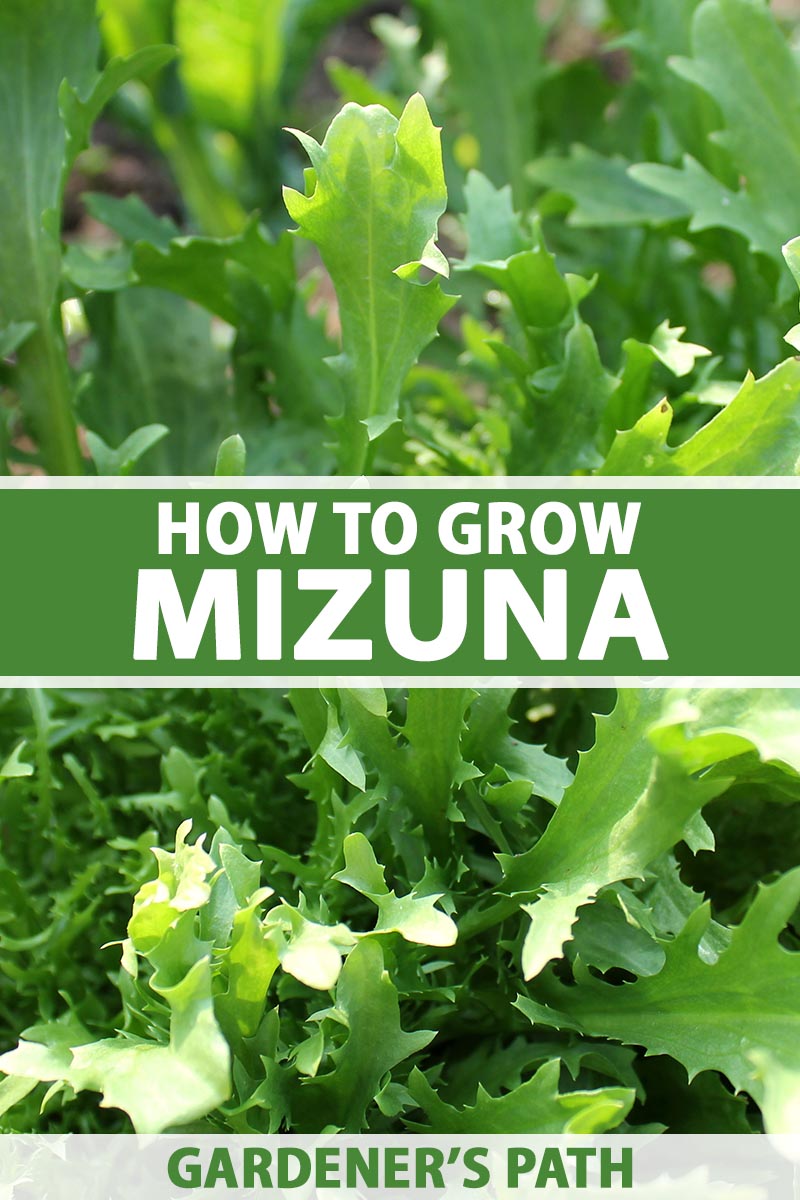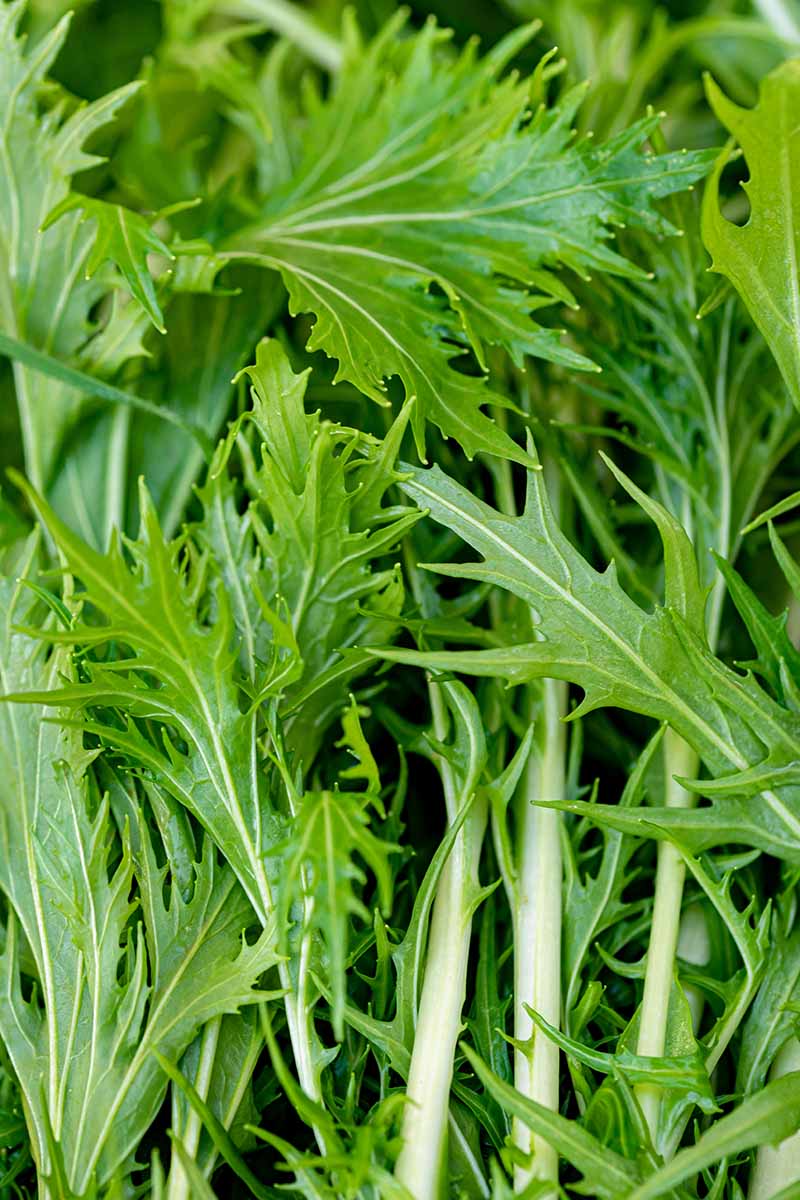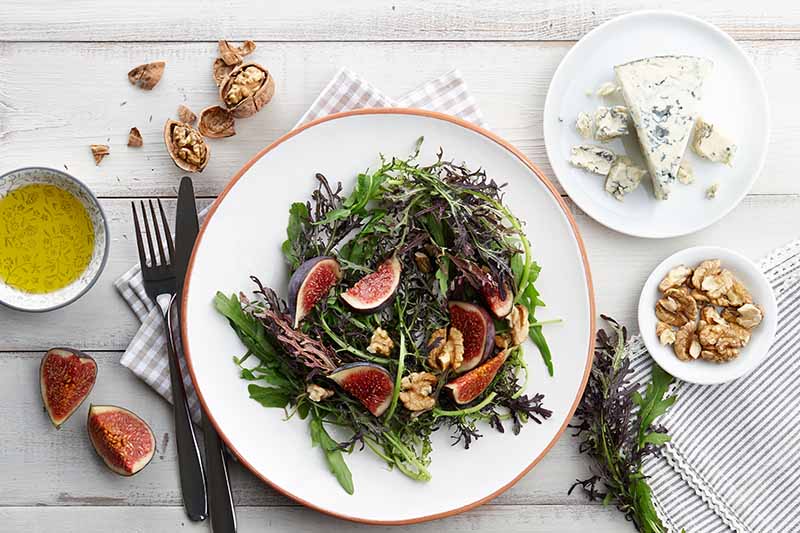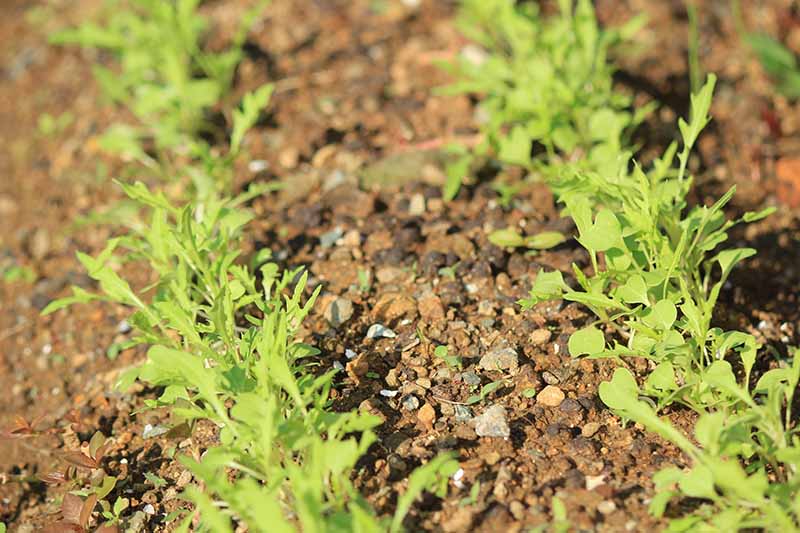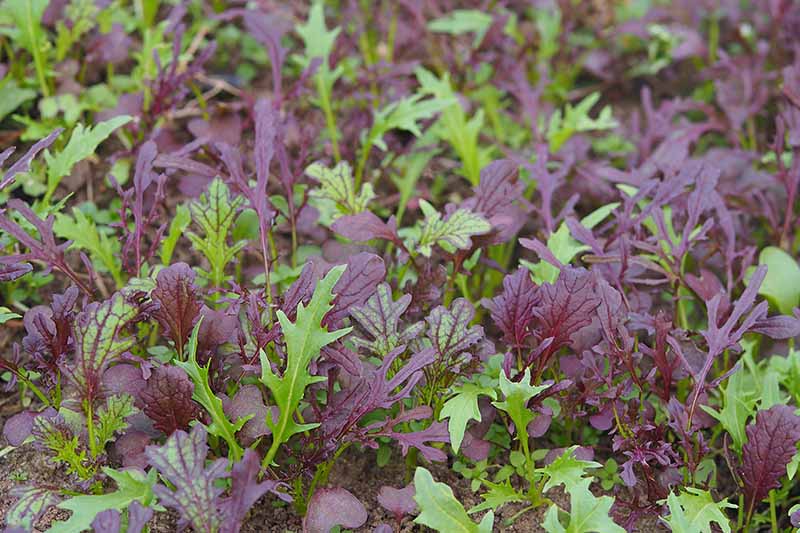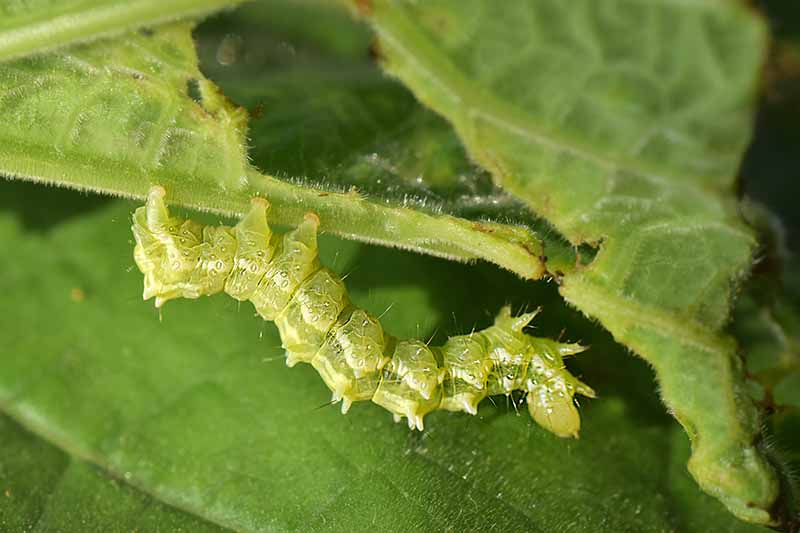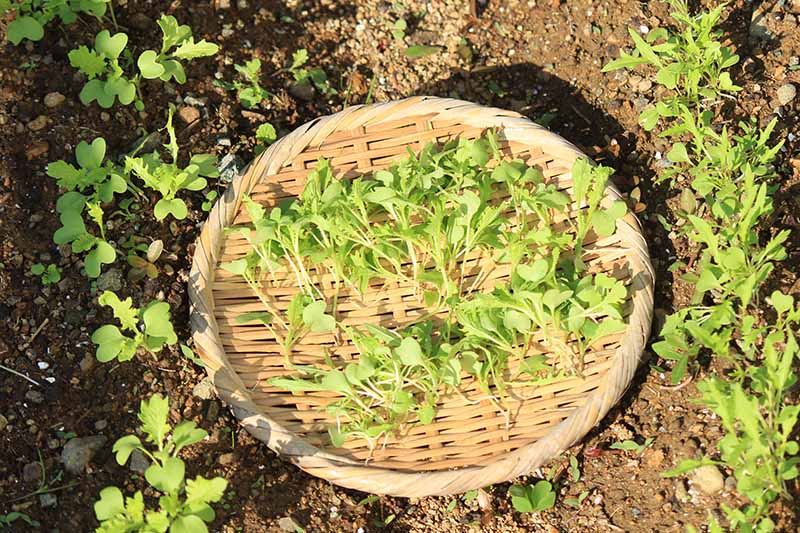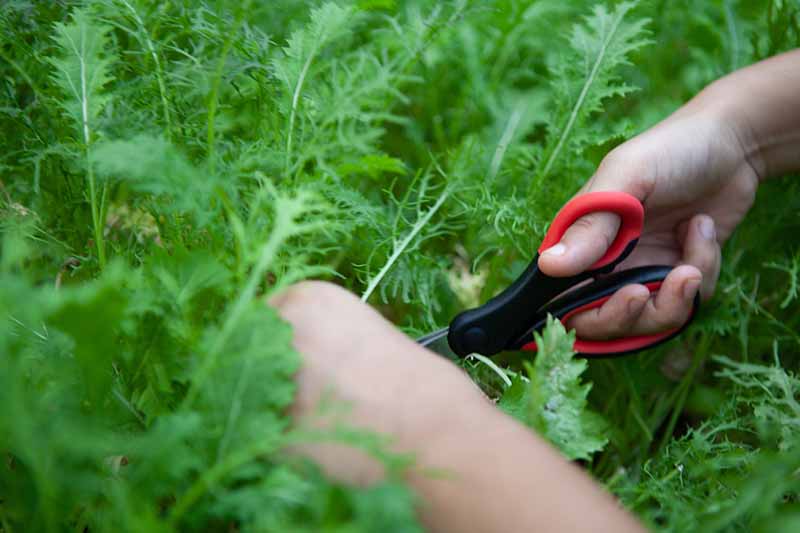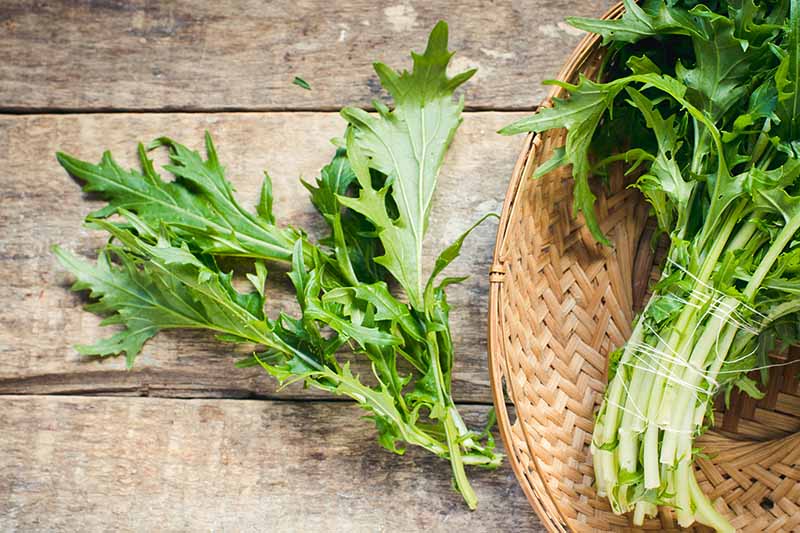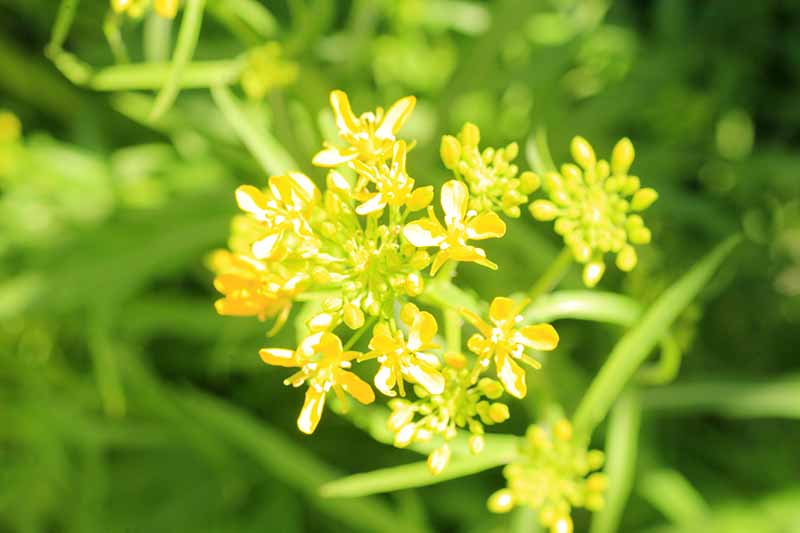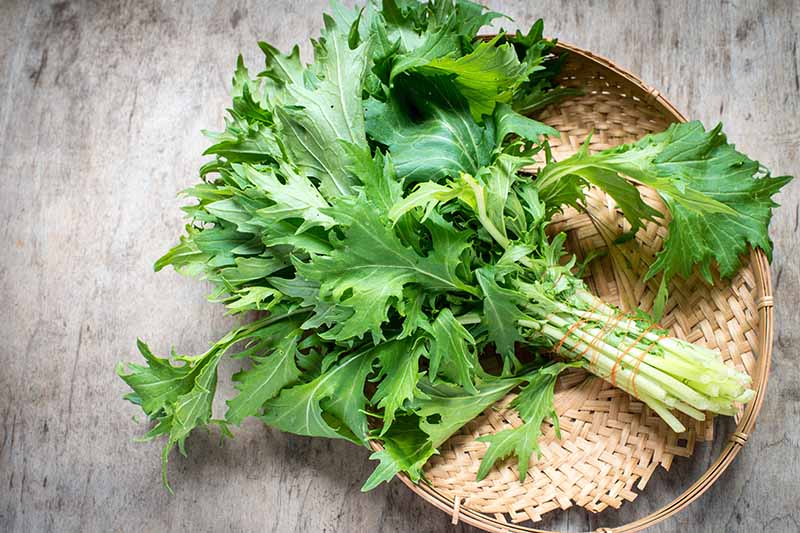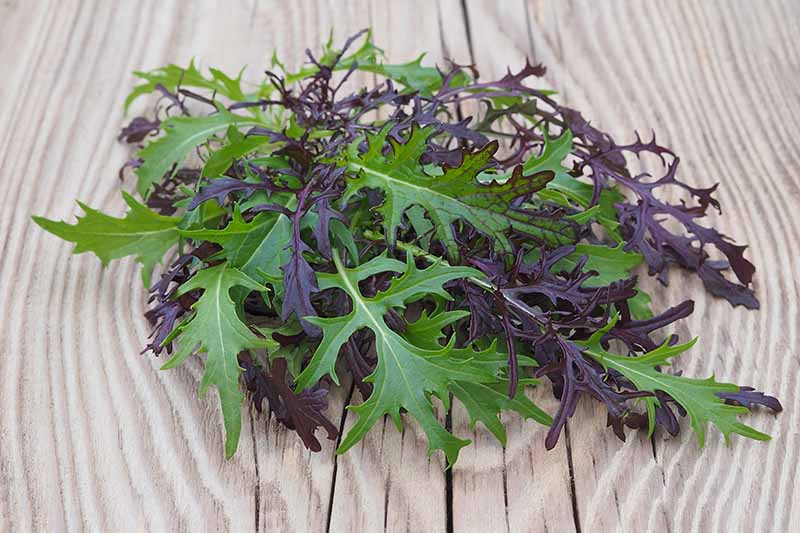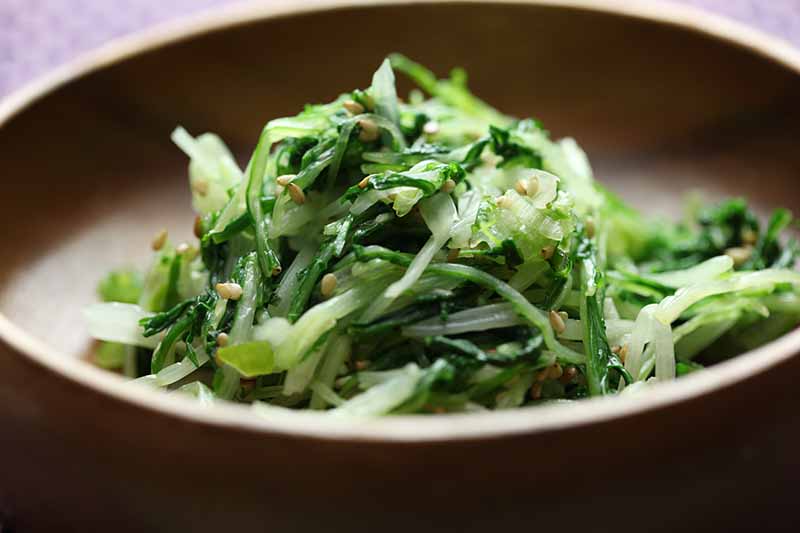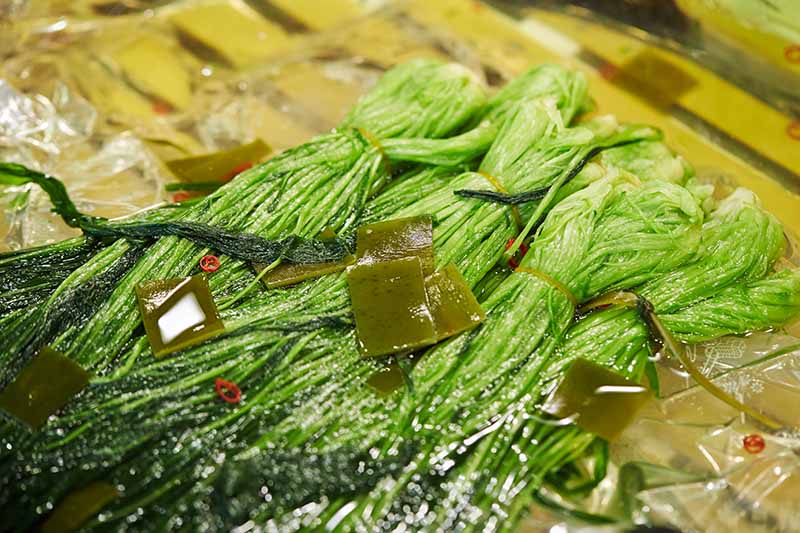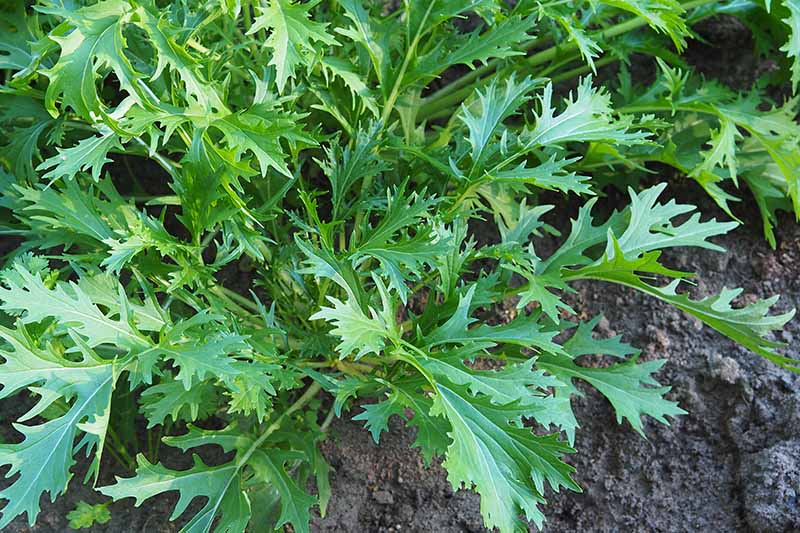I associate it with a magical New Year’s Day party in 2016. A chef friend made us all a braised vegetarian dish with this leafy Asian green, as part of the good luck meal that also featured black-eyed peas. That dreamy gathering also included a lop-eared dog underfoot, singing and mandolin music, and the best of friends all spending time together. But there are plenty of reasons to love mizuna that any vegetable gardener or home cook can get behind. It’s prized for its mild flavor in salads and stir fries, and its serrated green leaves form an attractive rosette for edible landscaping with ornamental appeal. You might also like how the plants grow so quickly, taking just 40 days from sowing to produce full-size leafy greens, or the way they’re able to tolerate both heat and cold. We link to vendors to help you find relevant products. If you buy from one of our links, we may earn a commission. It’s also appealing that there are so many ways to add them to your gardening repertoire, whether you’re a beginning veggie gardener or an old pro. And since seeds are usually sold at least 200 to a packet, you’ll still have enough left over to plant a second batch to harvest in the fall. I’m going to share some tips and techniques on all of the above, from sowing to saute pan. I hope you’ll join this growing party! Here’s what I’ll cover:
What Is Mizuna?
Mizuna is a mustard green with distinctive feathery leaves and a mild, sweet flavor. Its botanical classification as B. rapa var. japonica means it’s a relative of turnips, but in the kitchen, the two have different uses and flavor profiles. You may also sometimes see it referred to as mibuna, or B. rapa var. nipposinica. Mizuna leaves have just a hint of peppery bite, and respond best to quick cooking methods like steaming or stir-frying. In contrast, turnip greens pack a punch and are tasty stewed with ham hocks and other pork ingredients, or a savory broth. The plants tend to grow between four and 10 inches tall, and spread only a modest amount, from four to 15 inches. Some varieties have a mounding habit, while a couple of others grow upright. While it originated in China, the Japanese have cultivated this healthy vegetable since ancient times. It is sometimes called “kyona” in Asia, according to Kurt Nolte, an area agricultural agent with the Yuma County Cooperative Extension at the University of Arizona. This translates to “greens from Kyoto,” Japan’s ancient capital city. Because it is so tender and will resist bolting longer than other brassicas and most types of lettuce, mizuna is a common component in spring mix or mesclun, both for commercial growers and home gardeners. To learn how to start your own personal history with this easy-to-grow, tasty Asian green, keep reading.
How to Sow
The best time to sow mizuna in your garden is during a period of cool weather. It will grow in temperatures ranging from 45 to 75°F, though the cooler end of this range produces tastier, more mildly flavored leaves. Pick a spot with average soil that receives full sun, or partial shade. How big of a space will you need? For standard row planting, the basic rule of thumb is about six feet of row to feed four people, according to experts at the University of Michigan extension. I have my own corollary to that. Since I think tender, young leaves are the tastiest, I plant half of that amount in two plantings three weeks apart. No matter how much you’re planting, it’s ideal to start sowing about four weeks before the average last frost date in your area. To avoid common cole crop pests and diseases (or depleting the soil) choose an area where you haven’t grown any of its brassica relatives in the past two seasons. That means somewhere you haven’t planted arugula, broccoli, kale, bok choy, or even radishes. Prepare the garden bed by cultivating the soil down to about eight inches. Break up any clumps, and add some well-aged organic material like mushroom compost if the soil doesn’t drain well. If you have utterly unsuitable soil or inadequate sun exposure, consider planting mizuna in a container. That way, you can fill it with a growing medium specifically created for container vegetables, and you won’t have to worry about the native soil’s ability to drain. Pots can also be moved to find the sun. Different gardeners take different approaches to sowing, but the method that works well for me is planting a trio of seeds a quarter of an inch deep. I space the clusters every four inches, in rows about a foot apart. This is one of the rare times I don’t worry about planting too many seeds. I know I can always thin the sprouts, and eat or compost them. And the seeds are inexpensive and plentiful. I cover each row with about a quarter inch of vermiculite or seed starting mix, if I have some on hand. Then I firm the surface, and water gently. If you want to save labor, some gardeners like to just scatter the seeds over the surface of an entire bed, or within 12-inch-wide bands spaced four to six inches apart. Then they sift a thin layer of light soil or growing medium over the top, and water them in. The idea is to keep the seeds about an inch apart, but gardeners who go with the scattershot approach can’t expect precise results! With either sowing method, you should see sprouts within four to 10 days. If you’re interested in harvesting microgreens or baby leaves, start with more seeds per inch, up to six or eight. That way you’ll have a substantial number to eat when you thin or harvest the young shoots. It’s impressive how fast those tiny seeds produce food that’s green and tasty. (Or purple, or streaked, and just as tasty.) The color and sheer freshness are so welcome in the spring garden. Home cooks who are huge fans of baby greens or stir fry might want to make successive plantings. That way, you’ll have an uninterrupted supply for months on end, and can toss salads and make stir fries to your heart’s content. Plant more every two weeks until the cooler weather is winding down. Mizuna will tolerate light frost in the early days, and will still grow when temperatures exceed 70°F, at least for a few weeks. This leafy green lasts longer in heat without bolting than other types of mustard greens, and most other cole crops. If you have a short growing season, with temperatures topping 70°F quickly in late spring or early summer, consider seeding a final batch in part shade. You can also use a full-sun space, and employ either an umbrella or some strategically placed row covers for protection. They won’t make it cool enough to keep this crop producing into the heat of summertime once the scalding weather arrives, but providing a little shade should prolong the harvest. A simpler way to extend the harvest into the warmer months (we call this season “Hell’s Doorstep” here in East Tennessee): Grow a modest batch of the microgreens indoors. This requires only a wee bit of growing medium, a mat to provide bottom heat, and a dome cover for a container – or some clear plastic wrap. And it beats the heck out of wrangling with about-to-bolt, potentially bitter mizuna in sweltering weather. And don’t forget, you can probably plant another crop in late summer to have mild, fresh Japanese mustard greens that are ready to pick in early fall. To try this yourself, sow more seeds about five weeks before your first frost date. If the seedlings do get caught by frost late in the game, this tends to make them just a tad sweeter. Wouldn’t it be great if all of our favorite vegetables reacted so favorably to unexpected cold weather? That’s just another reason to love this Japanese mustard.
How to Grow
Caring for these tender vegetables after they sprout requires just a little labor, but a lot of attention. You’ll want to check them often to make sure they’re not overridden with weeds, for example. Once weeds gain a foothold, they’ll compete for water and nutrients, and usually win. Either apply vegetable-friendly mulch to keep the weeds down, or make sure you pull the offenders out promptly. This reminds me – if you tend to have a lot of weeds in your veggie plot, or you don’t always get around to hand pulling, you may want to pass on that sowing method where you scatter the seeds casually. If you have mustard growing all over the garden bed, you’ll have to weed by hand, which can be tedious. Only gardeners with nice neat rows (that’s me!) are able to eliminate weeds with a hoe, and without a lot of bending or kneeling. Because the tastiest greens come from rapid growth without any breaks in the action, you’ll also need to check that the mizuna is consistently getting enough water. The plants require about an inch of water per week to assure they’ll grow quickly. If the rain’s not providing it, make sure you do. Be careful not to get the leaves wet, though. That can encourage diseases to take hold. Water at the soil line. If you must use a hose or sprinkler, make sure to do so when there is still enough time for the sun to dry the leaves thoroughly before nightfall. You can also assure the healthiest crop by thinning the seedlings to stand four inches apart once they’re three inches tall. And shoot for 12 inches apart when they’re nearing maturity. That allows enough space for the ample air circulation that helps prevent fungal infections from developing or spreading rapidly.
Growing Tips
Thin seedlings to stand four inches apart when they are three inches tall.Keep the area free of weeds with mulch or frequent pulling. Water one inch per week at the soil level during dry spells.
Cultivars to Select
Even with this healthy veggie’s culinary popularity, mizuna seeds aren’t commonly available to home gardeners in the US.
Managing Pests and Disease
Even though it cooks more like spinach and looks a lot like fennel, mizuna is a brassica and attracts many of the same pests as other mustard plants, kale, and broccoli. Note that a lot of people just lump mizuna in with other frilly looking mustard greens, like ‘Ruby Streaks’ or ‘Golden Frills.’ But those two are actually types of B. juncea, known informally as Chinese mustard. It’s absolutely fine if you do end up with one of its relatives instead, since they’re also simple to grow and you can cook them in many of the same dishes.The seeds are sometimes easier to find, too. But be aware that other feathery mustards may be a bit more pungent than B. rapa var. japonica, and some are quicker to bolt in early summer heat, or take longer to grow to full size. Mizuna For a true variety, the open-pollinated, classic green type is most readily available. You can find seeds sold in packets and in bulk available at Eden Brothers. There are some more unusual varieties to consider as well, including these:
Central Red
Known as a “fine leaf” mizuna, ‘Central Red’ is a hybrid with extra narrow, deeply serrated foliage. It can reach 14 to 16 inches tall, but is best harvested at about six inches. It also spreads about eight inches if you don’t cut the outer leaves first, while they’re still tender. The color is the draw here – the bright green leaves have brilliant purple stems and veins. The combination provides a beautiful contrast to baby kale or romaine in mixed green salads. It’s also striking as part of an edible ornamental garden bed or container, especially when paired with early-blooming purple or yellow violas. ‘Central Red’ If you want the full effect of that shiny purple, though, remember that growing ‘Central Red’ under a row cover mutes the purple a bit.
Lime Streaks
A mounded baby leaf in a sassy lime green, ‘Lime Streaks’ grows five to seven inches tall and 12 to 15 inches wide at maturity. ‘Lime Streaks’ This is a nice choice for edible landscaping, particularly when planted to complement the rosy shades of beet greens, opal basil, or Swiss chard. ‘Lime Streaks’ seeds are available in various packet sizes and in bulk from True Leaf Market.
Miz America
The cultivar with the catchy name, ‘Miz America’ is a beautiful shade of red from the time it sprouts until it reaches its mature size. Known for being bolt resistant, it takes 15 days to produce harvest-ready microgreens, 28 days for baby leaves, and it can be harvested at full size between 50 and 60 days. ‘Miz America’ ‘Miz America’ grows with a more upright habit than some other cultivars, reaching 10 inches at maturity. This makes harvesting easier and keeps the leaves from getting muddy, since they don’t touch the ground. The plants spread four to eight inches. ‘Miz America’ is available from Burpee in packets of 500 seeds.
Red Streaks
This feathery, mottled, magenta and cream-colored Asian green is striking. Since it tolerates heat better than lettuce, but still has tender, frilly leaves, ‘Red Streaks’ is a big favorite for late spring and early summer salad mixes. Its maximum spread is about 12 inches. The thin stalks can grow to 14 to 16 inches tall. ‘Red Streaks’ They also have a slight peppery bite and are suitable for stir fries. Just be sure to separate them from the frills, since the stalks take longer to cook. ‘Red Streaks’ is also a standout microgreen, with red highlights amidst the green cotyledons. True Leaf Market sells ‘Red Streaks’ in packets, in bulk, and in quantities suitable for microgreens.
Pests
Here are four bugs to watch out for during the growth cycle:
Aphids
Aphids are persistent and can wreak havoc. The tiny sea green, red, apricot, or black bugs pierce leaf tissue and feed on the sap, which makes leaves yellow and curl. Insecticidal soap can take care of aphids if they’re not too numerous, but once they’ve done significant damage, you won’t want to eat the greens. If the foliage begins dying, or the aphids have left behind honeydew or their castoff skins(!), your best option is to pull up the plants, toss them in the trash, and start more seeds in a different container or part of the garden bed. Read more about aphids in the garden here.
Cabbage Loopers
The Trichoplusia ni adults are mottled moths, but the larvae are the ones to watch out for. These little green worms with white stripes on their sides chew holes in leaves, with the damage growing as the larvae increase in size. If cabbage loopers are a big issue, you can always plant your mizuna in the spring. The larvae are at their worst in the fall. As another preventive measure, use row covers on the seedlings to keep the adult moths from laying eggs where the larvae can then hatch and gnaw on the foliage. Learn more about how to control cabbage loopers in our guide.
Flea Beetles
Tiny, like their namesakes that plague pets, these bugs chew holes in mustard greens. They’re not as big of a threat for mizuna as they are for broadleaf varieties, which have a longer growing season that gives flea beetles more of a chance to do their thing. But they can still inflict some damage on more mature greens. Counter flea beetles early on with floating row covers. Or avoid them by growing this crop in the fall, when flea beetles have subsided. Read more about ridding your garden of flea beetles in this guide.
Slugs
While they share their name with humans who can’t get moving, slugs on leafy greens are quite lively, particularly at night, which is when they feed. They leave slime trails on the leaves, and who wants to see that in their salad spinner? Oh, yes, and they’re also the probable culprit if you spot large holes in the foliage. For me, the simplest way to avoid slugs is to grow the greens as early as possible in the spring, and harvest them while the weather is still chilly and less hospitable to slugs. Slugs are most active, and get bigger quickly, at temperatures between 62 and 64°F, according to entomologists at the University of Florida. The slimy gastropods may still lay eggs and grow – just more slowly – if the temps dip lower than that, but growing any greens in chilly temps helps to prevent slugs. If you’re determined to have full-size leaves, or have other reasons for growing later in spring, beware of slugs during periods of damp weather. This isn’t for the faint of heart, but if you detect their damage, you can slip into the garden in the dark of night and pluck the offenders off your precious plants using your hands. Be sure to bring a flashlight to help you hunt them down. Another solution is to form a barrier of diatomaceous earth in the soil around your plants. It’s uncomfortable for the slugs to traverse DE, granular soil, or even coffee grounds. Read more about protecting your garden from slugs and snails here.
Disease
If you give these greens enough space for proper air circulation, water them consistently so they grow quickly, and do your best to prevent infestation by insects that carry pathogens, you probably won’t have much trouble with disease. If you do end up with diseased plants, get them out of your garden bed speedily and completely. Not only will many of these diseases spread rapidly to nearby vegetables, some will infect insects that then overwinter in your soil or on garden debris, or bugs may carry the pathogens to other parts of the garden. The ones most likely to give cause for concern are typically fungal or bacterial, though you may run up against a virus or nematode occasionally, too.
Anthracnose
Caused by Colletotrichum higginsianum, anthracnose is a fungal infection that spreads via splashing water. It forms small, circular patches that can render leaves inedible.
Bacterial Leaf Spot
The result of Pseudomonas maculicola reaching the plants and causing infection, bacterial leaf spot first shows up as tiny circular spots on the top surface of the leaves. As the disease progresses, the spots expand and join together to form large brown areas, and the undersides of the leaves may appear water-soaked.
Damping Off
Since it’s simplest to start mizuna from seed, you’ll need to pay extra attention to damping off. Just as your seeds have sprouted, and are looking green and healthy, this is probably the culprit if they all keel over without warning. What went wrong? The fungus that causes damping off is activated when conditions are overly moist, and air temperatures top 68°F. Its presence also indicates soil that has too much nitrogen.
Downy Mildew
Downy mildew is another common foe, caused by the fungus Peronospora parasitica. It creates white-gray lesions on the leaves, starting on the undersides. To avoid downy mildew, make sure to plant seeds at the recommended spacing and thin as needed. Also, never pick or weed while the leaves are wet from rain or supplemental watering, and always try to water at the soil line, not from overhead.
White Rust
Caused by the water mold Albugo candida, white rust creates deformities in mustard green leaves. The top strategy for preventing it, and all of the other diseases described above, is protecting your garden plot from overwatering. It’s also important to give seedlings enough room so the leaves don’t stay moist after rain or watering, which can create a hospitable environment for these damaging pathogens. Be sure to purchase high-quality seed, too. Seed from unknown sources may already be infected with pathogens when you plant. Find tips on identifying and controlling mustard green pests and disease here.
Harvesting and Storage
How time flies! These leafy vegetables are ready to eat very quickly. You can start to harvest them as soon as the seedlings form a set of true leaves and are at least two inches tall. If growing conditions are optimal, that could be just two weeks from sowing. Thin them to stand four inches apart, pulling the tiny sprouts up, roots and all. Wash the thinnings and let them drip dry on a clean dish towel, and you have a nice addition to spring salads, or a garnish for soup, casseroles, or pizza. Pick baby leaves once the foliage is about three or four inches tall. That usually takes about 21 days from sowing. You can use the “cut and come again” method to harvest the outer leaves. Sever them about an inch above the crown to wash and use in your favorite recipes. The inner leaves stay behind to keep growing. Rinse baby leaves lightly, and either dry them in a salad spinner or on a clean, dry dish towel before serving. You can place them in a resealable plastic bag and they’ll stay fresh in the fridge for a day or two, but they lose flavor and texture quite quickly. Once the leaves are more than four inches long, the salad days are over. The longer ones, up to about eight inches, are still tasty in a stir fry, but they’re too tough to serve raw. If they get much taller than eight inches or so, they become stringy and bitter. More mature leaves can make flavorful add-ins for green juices and smoothies, but once they’re taller than about 10 inches, they tend to become so bitter I’d just send them to the compost pile. You can also cut the baby leaves, or four to eight-inch outer leaves, on an as-needed basis. Just make sure you don’t take more than one-third of the foliage at a time, or the plant might wilt or die instead of growing a fresh set of leaves. At some point, you’ll want to cut the entire rosette. I do this once the leaves are about 40 days old and six inches tall. I also cut the whole plant if I’m planning to cook a lot of mizuna at once. Like spinach, a heaping pile cooks down to about half its size after just a minute or two of sauteing or steaming. Coming up, I’ll share a method for stir-frying mizuna. It requires six to eight cups minimum to serve four people. To harvest a mature head, cut it below the crown with a sharp knife. For the freshest taste and the most nutritional impact, pick the leaves just before you’re ready to cook them. You can store full-size leaves wrapped in a damp, clean dish towel in the fridge. But try to cook them within a couple of days. After about three days, they’ll be shriveled or spoiled, not at all the garden-fresh ingredient you’ve worked so hard to grow. And make sure you pick what you want before the weather gets so hot that the plants start flowering. Even a plant that’s still just five or six inches tall tastes terrible once it blooms. The leaves are overly hot and a bit cabbagey at this point, a taste I describe as dog-dragon breath flavor. Please, avoid that fate! One last note on the harvest: If time gets away from you and you haven’t harvested all you had hoped to before the temps get hot in the summer, you can let the plant bloom. Then cut those delicate flowers from the tips and eat them! Ideally, slice or pinch the buds before they’re in full bloom. Use a paring knife, your fingers, or scissors to snip the top inch or so of the blooming stalk. The small buds taste almost like spicy broccoli. I mean a not too hot or bitter, “just the right amount of zing” spicy broccoli. They work great as edible blooms for garnishes, or they can be added to stir fry to cook for about a minute right before serving. Should you have the space, you can also leave the flowering stalks alone. Bees and other pollinators really appreciate them. Just make sure to till them into the soil or put them in the compost once the seed pods start forming. If you don’t, they may harbor insect pests that like to overwinter in the greenery. You can let the pods dry completely and then save the seeds inside them to grow next year too. This process is especially valuable if you like to have a stash of mustard green seeds on hand for microgreens throughout the winter. Still, be careful to uproot the dead plants once you’ve saved seeds. It’s agonizing to let pests like flea beetles gain a foothold in the garden by overwintering in your mizuna.
Preserving
If you want to keep some around for the cold months, you can blanch and freeze the harvest. Just remember to only boil the leaves in water for about a minute, so they won’t overcook and lose all their texture. Then quickly dip them into a bowl of ice water to halt the cooking process and leave them a vibrant color. Drain them really well, first in a colander and then on laundered dish towels or paper towels. Lay the leaves flat before freezing, whether you choose to store them in freezer bags or shallow plastic containers with airtight lids. If you let them clump up, they’ll clump when they’re defrosted, too. You can also use a small amount of this Asian green in place of spinach in recipes that freeze well, such as spinach lasagna or lentil soup. Speaking of which…
Recipes and Cooking Ideas
You don’t have to be a professional, personal chef, or even an experienced home cook to create delicious salads, wraps, or stir-fry with the baby leaves or mature greens. When you’re cooking with it, think of mizuna more like spinach than a long-cooking pot green. It does not fare well when simmered for hours in pork or ham broth the way some folks like to fix collards or larger mustard green varieties, such as ‘Red Giant’ or ‘Florida Broadleaf.’ Chop the leaves and add them to soups or stir fries, but add them at the end, and cook just long enough for them to wilt. Stew them for more than a few minutes and they’ll get limp, and then slimy, and lose their piquant flavor. Similar to spinach, you can add baby leaves that are just a few weeks old to sandwiches and wraps, mesclun mix, and other raw salads. Once the leaves are more than two or three inches long, though, they’re too tough and bitter to enjoy raw. Be sure to pickle or cook them instead, once they’re full-grown. It’s a good idea to sever the stalks from older leaves before cooking, too. The stems need two or three extra minutes of simmering to be crisp and tender. If you cook the leaves just as long, the stalks will be crisp and the greens will be overcooked. You can also stir chopped leaves and stalks into rice pilaf in the last couple of minutes of cooking. Or, add them in place of some or all of the escarole in this Italian wedding soup from our sister site, Foodal. But instead of allowing them to cook for 30 minutes like the escarole would, add them in the last three minutes of cooking for the tastiest results. For a basic stir fry or side dish, follow these steps:
- Use about a tablespoon of light oil like canola or peanut for every 10 cups of mizuna. Clean the leaves and chop them into two-inch pieces, keeping the stalks separate.
- Heat the oil in a large, heavy skillet over medium-high heat. If you like, add three or four minced cloves of fresh garlic and stir fry for one minute.
- Add the mizuna a handful at a time, starting with the stalks. Let them cook for two minutes, then add the leaves, stirring with a wooden spoon or heat-proof spatula after each addition. Cook the mixture for two or three minutes.
- Top with soy sauce to taste, or salt and pepper. Serve immediately, with a squeeze of fresh lemon juice on top if you like. You can also pickle your mizuna and serve it in myriad ways. A couple of tablespoons pep up stir fry or noodle bowls, and some swear by these as a side with over-easy eggs. I haven’t been adventurous enough to try them scrambled into “green eggs” yet myself, but I understand that’s also quite delicious as a “breakfast for dinner” entree. Also good for larger leaves, this is my basic approach for quick pickles. Keep in mind that these are not the kind you preserve in a water bath canner. They are “refrigerator pickles” that stay good in the fridge for a week, no longer. You can vary the type of sugar you use, or try different varieties of raw or dried hot peppers, depending on your tolerance for heat. I’ve also made these with a couple of tablespoons of balsamic vinegar and the rest white vinegar. They’re not as mild as the ones made with rice vinegar, but they’re still smooth and a little sweet. To make quick mizuna pickles, cut the stems from a half pound of greens and chop them into half-inch pieces. Cut the greens into one-inch pieces, and pack both loosely into a clean, dry quart-size glass jar with a lid. In a medium saucepan, stir a quarter cup of rice vinegar, two teaspoons of granulated sugar, and a dried cayenne pepper into two cups of filtered water. Stirring constantly, bring the mixture to a boil over medium heat. Using a funnel, pour the hot mixture over the greens. Run a wooden skewer or chopstick around the inside walls of the jar to dislodge any air bubbles. Let the mixture come to room temperature, and it’s ready to eat. If you’re not going to consume it right away, cover with a lid and store in the fridge for up to a week. Drain before eating or adding to your favorite dish, but leave enough brine in the container to keep the remaining pickles submerged. Try adding a handful or two to a batch of sweet and green carrot juice, also from Foodal. Or blend some baby or mature greens into a healthy green smoothie. To freeze a bumper crop into homemade soups or casseroles in place of spinach, try Foodal’s recipe for vegetarian fresh and fruity lasagna. Or make a batch of kale lentil soup with mizuna in place of the kale! Remember, you can grow it in a container, in a garden plot, or on a fiber pad for sprouts or baby greens. You might use your microgreen harvest to experiment with making anything from pickles to salads to pizza toppings. If you let the leaves mature to full size, you can use them to rev up sautees, soups, or dips – or perhaps as your first freezer greens. And you can pickle those too, or blend them into healthy beverages. So tasty! Just one affordable package can seed several plantings. If the first method you tried didn’t work out, well, you’ll probably have plenty of time to try another before the growing season is over. Do you have your own ideas about ways to grow or how to best enjoy this tasty Asian mustard? Please share! There’s a comment section at the end of this article, and responsive experts will join the conversation, too. And if you’re intrigued about this or any other mustard green varieties, we’ve got lots of great growing information for you to read next, starting with these guides:
How to Grow and Care for Mustard GreensHealth Benefits of Mustard Greens
